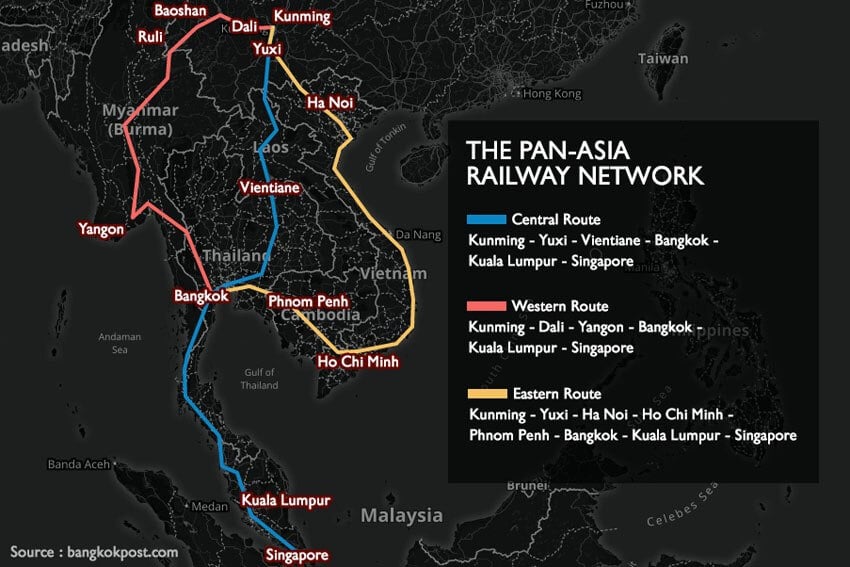Last updated July 22nd, 2023.
Over the past decade, Southeast Asia’s economy grew at an unprecedented rate. Investors in turn have poured billions of dollars into the region’s businesses, real estate, and infrastructure.
High speed rail lines, which are cropping up throughout the region, are one of the areas where foreign investment is most widespread.
Chinese companies are now building a high speed rail system that will link Kunming, Laos, and Thailand. Likewise, Vietnam is planning on giving its current rail system a much-needed facelift.
All of these high speed rail projects will greatly boost local economies by promoting trade and tourism while providing plenty of work for local companies and citizens. Additionally, they will provide better access to more rural parts of the region that are difficult to reach.
While high speed rail lines will surely benefit Southeast Asia, it hasn’t been the smoothest ride. Large-scale infrastructure projects are time, cost, and labor intensive.
Malaysia, for instance, has halted development on its high speed rail link from KL to Singapore, citing national debt concerns.
But despite a few occasional setbacks, high speed rail is moving along in Southeast Asia and its impact on the region will be tremendous. Therefore, we’ll look at:
- China and Japan’s influence on SEA’s high speed rail projects.
- How these projects might bring Laos up to speed.
- The future of high speed rail in Southeast Asia.
Foreign Investment: China Versus Japan
One of the driving forces behind these new high speed rail projects is foreign investment from both China and Japan.
Japan has long been a pioneer in the realm of high speed rail. The country started building its Shinkansen railway lines – commonly known as bullet trains – as early as the 1960s. Nowadays, Japan arguably has most extensive and efficient railway system in the world.
As a result, Japan has become a natural partner for countries looking to build high speed rail networks of their own, including Vietnam and Thailand.
Japan partnered with the Asian Development Bank to finance and provide technical assistance for railways across SEA. Meanwhile, Vietnam is seeking Japanese development grants in order to rebuild its aging railway system.
Yet Japan’s influence in the region has began to wane thanks to a combination of challenges at home and the rise of China.
As Japanese rail projects have stalled, China continues to push forward with expansive railway systems to connect its southern cities with major Southeast Asian hubs.
China has already begun construction on an ambitious railway project that intends to connect Kunming with cities such as Vientiane and Bangkok. Construction on the project is underway in Laos, and China is now in negotiations with the Thai government to start construction.
However, while China continues moving at full steam with its projects in Laos and Thailand, the country’s growing dominance in the region is drawing criticism from political opponents.
Vietnam, as a longtime rival in China, has grown concerned with the Chinese railway project in Laos. They claim that Laos is at risk of becoming a “client state” of China because of debt from expensive railway projects.
Similarly, high speed rail projects intended to connect Malaysia and Singapore have halted due to the Malaysian government’s concerns over their national debt and Chinese influence.
Regardless of any short-term roadblocks, Chinese influence across Southeast Asia will almost surely continue expanding though.

Southeast Asia’s high speed rail network will eventually connect China with countries as far away as Singapore.
High Speed Rail Lifts Up Laos Economy
As a result of their central locations, two countries will benefit most from the development of high speed rail in Southeast Asia – Thailand and Laos.
Thailand was referred to as an “Asian Tiger” in the 1980s because of its impressive economy. Growth is slower than it once was, although still superior compared to just about anywhere in the western world.
Its profitable tourism industry, status as a regional transit hub, and growing middle class have propelled Thailand’s astounding growth since the late 20th century. High speed rail will surely supplement it.
Laos, on the other hand, notably lagged behind its neighbors in terms of economic growth.
The UN now classified Laos as one of the least developed in the world. And unlike neighboring Cambodia, its population isn’t quite large enough to captured the interest of foreign investors or multinational firms.
Combined with a general unfriendliness toward foreign citizens and its difficult terrain, such factors cause weak growth in this landlocked country. It’s no wonder why the Lao government eagerly embraces high speed rail development.
The construction of Lao high speed rail itself has already boosted local restaurants, hotels, and transportation services. Once the railway is fully operational, connecting to Thailand and beyond, Laos hopes to take advantage of easier trade routes and attract tourists from neighboring countries.
While high speed rail certainly has the potential to bring a much-needed surge to the Laotian economy. The ballooning cost of the railway has also raised concerns about the country’s debt to China.
Because the country’s terrain is very mountainous, builders encounter difficulties constructing railway, leading to increasing costs and consequently Laos’ debt to China. Rising debt levels in Laos have brought up concerns that they may become subservient to Chinese interests.
Despite these issues, the Lao government insists that the benefits will outweigh the costs. And that revenue generated from trade and tourism resulting from the railway will eventually allow the government to repay its debts.
Time will tell on the topic of debt. For now, a newly finished high speed rail system gives Laos a sorely needed economic boost.
Future of High Speed Rail in Southeast Asia
Whether built by China or Japan, high speed rail will surely play an important role in Southeast Asia’s economy in the next decade. Rail will most noticeably impact three development areas: trade, tourism, and rural communities.
New rail lines between Malaysia, Thailand, Laos, and China will strengthen trade partnerships among these countries by reducing transportation costs and increasing efficiency. Trains will also bring tourists to areas of these countries that are difficult to reach.
Rural communities along these rail lines will especially see an economic boost from hospitality revenue during construction. New job opportunities will arise after projects finish as business is lured by greater connectivity options.
The vast economic benefits of new railways can be tremendous. However, the future of high speed rail in Asia remains uncertain in some parts of the region.
Vietnam, for instance, is resisting Chinese involvement in its railway projects. The country has long desired to give its aging rail networks a major renovation. Yet the costs of the project may outweigh its benefits, particularly as budget airlines rapidly expand across Vietnam.
Malaysia also stalled a high speed railway to Singapore, citing similar concerns. Former Prime Minister Mahathir Mohamad made postponing this project one of his very first actions upon taking office back in 2018.
But despite some holdouts, high speed rail appears to have made its way to Asia. It won’t leave anytime soon.
Skip the Next Western Recession
Learn the best places to invest - and where to avoid - by downloading our free Investment Cheat Sheet.







